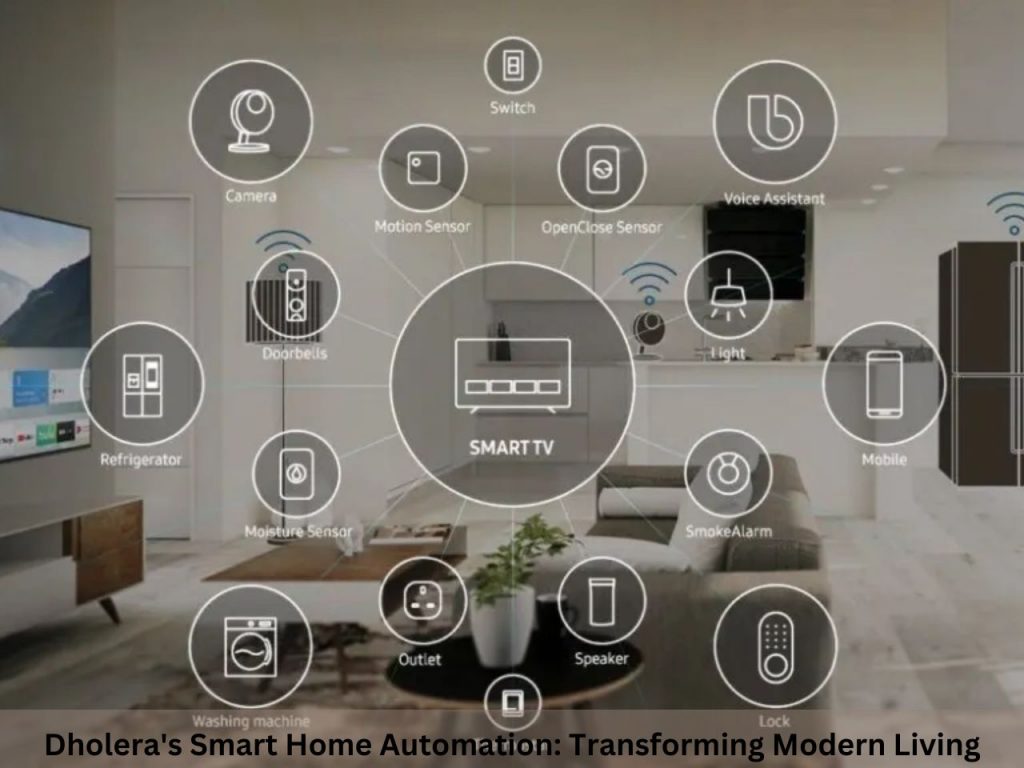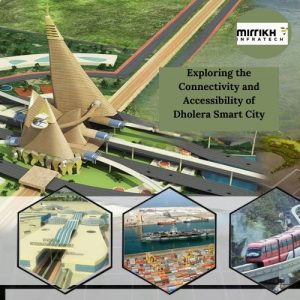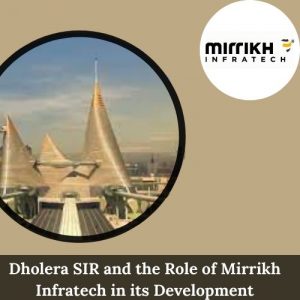In the heart of Gujarat, India lies the visionary city of Dholera, a planned metropolis that epitomizes the future of urban development. As part of the Delhi-Mumbai Industrial Corridor (DMIC), Dholera aims to become a global manufacturing and trading hub. One of its standout features is the integration of smart home automation, redefining modern living with cutting-edge technology. This blog explores the innovative aspects of Dholera’s smart home automation, highlighting how it transforms daily life, promotes sustainability, and sets new standards for urban development.
The Vision of Dholera
Dholera Special Investment Region (SIR) is designed to be India’s first greenfield smart city, covering over 920 square kilometres. It is not just a city but a paradigm of urban planning, sustainability, and technological advancement. Central to this vision is the concept of smart homes, which are integral to creating a seamless, efficient, and sustainable living environment.
Dholera SIR’s master plan includes residential, commercial, and industrial zones, all interconnected by advanced infrastructure. The city’s development is guided by the principles of smart growth, with a focus on creating a high quality of life for its residents. This involves leveraging technology to enhance every aspect of urban living, from transportation and energy management to healthcare and education.
What is Smart Home Automation?
Smart home automation refers to the use of technology to control and automate household systems and appliances. This includes everything from lighting, heating, and cooling systems to security, entertainment, and even household chores. Smart homes use the Internet of Things (IoT) to connect devices, allowing them to communicate with each other and be controlled remotely through smartphones or voice assistants.
The core components of smart home automation include:
IoT Devices: These are the building blocks of a smart home, including smart bulbs, thermostats, cameras, locks, and appliances. Each device can be controlled individually or integrated into a broader system.
Connectivity: High-speed internet and robust network infrastructure are essential for seamless communication between devices. Dholera’s advanced fibre-optic network ensures reliable connectivity.
Control Hubs: These are central units that manage and control smart devices, such as Amazon Echo, Google Nest, or dedicated home automation hubs. They allow users to control multiple devices through a single interface.
Automation Software: Software platforms enable the creation of automated routines and scenarios, such as turning off lights when no one is home or adjusting the thermostat based on weather conditions.
Key Features of Smart Home Automation in Dholera
1. Energy Efficiency
Energy efficiency is a cornerstone of smart home technology in Dholera. Homes are equipped with advanced energy management systems that monitor and optimize energy usage. Smart thermostats, automated lighting, and energy-efficient appliances help residents reduce their carbon footprint and lower utility bills.
Smart Thermostats: Devices like Nest or Ecobee learn residents’ schedules and preferences, adjusting heating and cooling to optimize energy use without sacrificing comfort.
Automated Lighting: Smart bulbs and switches can be programmed to turn on/off based on occupancy, time of day, or natural light levels, reducing unnecessary energy consumption.
Energy Monitoring: Real-time energy monitoring systems provide insights into energy usage, helping residents identify and address inefficiencies.
2. Enhanced Security
Smart security systems in Dholera homes provide peace of mind with features like surveillance cameras, motion sensors, and smart locks. These systems can be controlled remotely, allowing homeowners to monitor their properties from anywhere in the world. Real-time alerts and automated responses ensure a higher level of security and protection against intrusions.
Surveillance Cameras: High-definition cameras with motion detection and night vision capabilities offer comprehensive property monitoring. Footage can be accessed remotely and stored in the cloud for future reference.
Smart Locks: Keyless entry systems enhance security and convenience. Homeowners can lock/unlock doors remotely, grant temporary access to guests, and receive alerts for unauthorized access attempts.
Intrusion Detection: Integrated alarm systems and motion sensors detect and respond to potential security breaches, triggering alerts and activating deterrent measures.
3. Convenience and Comfort
The integration of smart devices offers unparalleled convenience and comfort. Voice-activated assistants like Amazon Alexa and Google Assistant allow residents to control their homes with simple voice commands. Automated lighting, climate control, and entertainment systems create a personalized living experience that adapts to individual preferences.
Voice Control: Residents can control lights, thermostats, music, and more using voice commands, streamlining daily tasks and enhancing convenience.
Smart Entertainment: Integrated home entertainment systems provide seamless access to streaming services, music, and smart TVs, all controllable through a single interface.
Automated Routines: Customizable routines can automate daily tasks, such as turning on lights at sunset, brewing coffee in the morning, or playing relaxing music in the evening.
4. Health and Wellness
Smart home automation extends to health and wellness features, such as air quality monitors and smart water purifiers. These systems ensure a healthy living environment by maintaining optimal air and water quality. Additionally, smart fitness equipment and health monitoring devices help residents maintain a healthy lifestyle.
Air Quality Monitoring: Devices that monitor indoor air quality and detect pollutants, allergens, and humidity levels, ensuring a healthy living environment.
Smart Water Purifiers: Advanced water filtration systems that ensure safe drinking water by removing contaminants and providing real-time water quality data.
Health Monitoring: Wearable fitness trackers and smart scales that sync with home automation systems to provide comprehensive health and wellness data.
5. Connectivity
High-speed internet connectivity is essential for smart home automation. Dholera’s infrastructure includes robust fibre-optic networks, ensuring seamless connectivity for all smart devices. This connectivity not only enhances the functionality of smart homes but also supports remote working, online education, and entertainment.
Fiber-Optic Network: High-speed internet access is the backbone of Dholera’s smart home ecosystem, enabling rapid communication between devices and the cloud.
Seamless Integration: Reliable connectivity ensures that all smart devices work together harmoniously, providing a cohesive and efficient home automation experience.
Support for Remote Work and Education: With high-speed internet, residents can easily work from home, attend online classes, and engage in virtual meetings without connectivity issues.
Benefits of Smart Home Automation
1. Improved Quality of Life
Smart home automation enhances the quality of life by making daily tasks easier and more efficient. From automating mundane chores to providing advanced security features, smart homes offer a level of convenience that significantly improves day-to-day living.
Time Savings: Automation of routine tasks frees up time for residents to focus on more important activities, enhancing overall productivity and well-being.
Customization: Personalized settings and routines allow residents to create an environment that suits their lifestyle and preferences, increasing comfort and satisfaction.
2. Cost Savings
Energy-efficient systems and appliances lead to substantial cost savings over time. Automated energy management reduces wastage and optimizes usage, resulting in lower electricity and water bills. The initial investment in smart technology pays off through long-term savings.
Reduced Energy Bills: Smart thermostats, lighting, and energy monitoring systems help minimize energy consumption, leading to significant cost savings.
Efficient Resource Management: Smart water management systems ensure efficient use of water resources, reducing wastage and lowering utility bills.
3. Sustainability
Smart home automation contributes to a sustainable environment by reducing energy consumption and minimizing waste. The use of renewable energy sources, such as solar panels, further enhances the sustainability of smart homes in Dholera.
Environmental Impact: By optimizing energy and resource use, smart homes reduce the overall environmental footprint, contributing to a greener planet.
Renewable Energy Integration: Solar panels and other renewable energy sources can be integrated into the smart home system, providing clean and sustainable energy.
4. Increased Property Value
Homes equipped with smart technology are more attractive to buyers and can command higher prices in the real estate market. The integration of smart home features adds significant value to properties, making them a wise investment for the future.
Market Appeal: Smart homes appeal to tech-savvy buyers who value convenience, efficiency, and modern living.
Long-Term Investment: The enhanced functionality and energy efficiency of smart homes make them a valuable long-term investment.
Challenges and Considerations
1. Initial Cost
The initial cost of setting up a smart home can be high, which may be a barrier for some residents. However, the long-term benefits and cost savings often outweigh the initial investment.
Upfront Investment: Smart home devices and systems require an initial investment, which may be significant depending on the level of automation desired.
Cost-Benefit Analysis: Residents should consider the long-term savings and benefits when evaluating the initial cost of smart home automation.
2. Privacy and Security Concerns
The interconnected nature of smart homes raises concerns about privacy and data security. It is essential to implement robust security measures to protect against cyber threats and ensure the privacy of residents.
Data Protection: Ensuring that personal data and information are secure is critical in a smart home environment. This involves using encrypted connections and secure devices.
Cybersecurity Measures: Implementing strong cybersecurity protocols, such as firewalls, antivirus software, and regular updates, helps protect against potential threats.
3. Technological Compatibility
Ensuring compatibility between various smart devices can be challenging. It is important to choose devices and systems that can seamlessly integrate and communicate with each other.
Interoperability: Selecting devices that are compatible with common home automation platforms ensures seamless integration and avoids compatibility issues.
Future-Proofing: Investing in scalable and upgradable systems helps ensure that the smart home remains compatible with future technologies and devices.
The Future of Smart Homes in Dholera
The future of smart homes in Dholera is bright and full of potential. As technology continues to evolve, so will the capabilities of smart home automation. The integration of artificial intelligence (AI) and machine learning will further enhance the functionality and personalization of smart homes.
Moreover, the adoption of renewable energy sources and sustainable practices will continue to drive the development of eco-friendly smart homes. The smart city of Dholera serves as a model for other cities around the world, demonstrating the transformative power of technology in urban living.
Conclusion
Dholera’s smart home automation is a testament to the city’s commitment to innovation, sustainability, and improved quality of life. By integrating cutting-edge technology into everyday living, Dholera is setting new standards for urban development and redefining the concept of modern living. As smart home technology continues to advance, the residents of Dholera can look forward to a future that is not only convenient and efficient but also sustainable and secure.




